Costa Rica’s northern Caribbean coast is famous for its nesting sea turtles. These gentle sea dwellers come to shore secretly at night to lay their eggs, then vanish back into the turbulent ocean before dawn. When visiting Tortuguero, it’s possible to witness this magical event. In this post, we’ll tell you what it’s like to go on a sea turtle nesting tour and why it’s so important that you do.
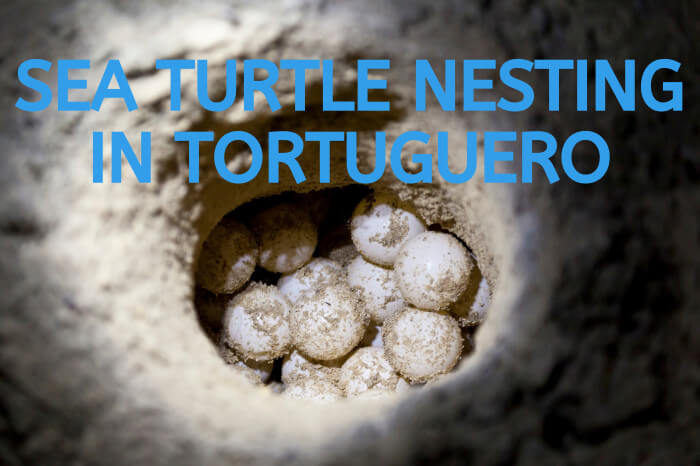
Background
Tortuguero is a remote destination along Costa Rica’s northern Caribbean coast. There are no roads since the landscape is swampy and wet. Instead, you must arrive by boat or small plane.

A handful of different turtle species lay their eggs on Tortuguero’s beaches. The most abundant is the Atlantic green sea turtle, which appears frequently from July through October. Less common are giant leatherback sea turtles, which arrive sporadically from March through May. One other turtle species, the hawksbill, is occasionally seen as well.
In the Face of Danger
With little to no development, the long, blackish sand beaches of Tortuguero appear to be a safe place for nesting turtles. However, there are several dangers these creatures face.
The biggest threat is poachers, who steal the turtle eggs. Sometimes they even kill the defenseless turtles in the process. The illegal eggs are sold to unscrupulous restaurants or street vendors. Some people think these eggs are an aphrodisiac and will pay a premium for them.
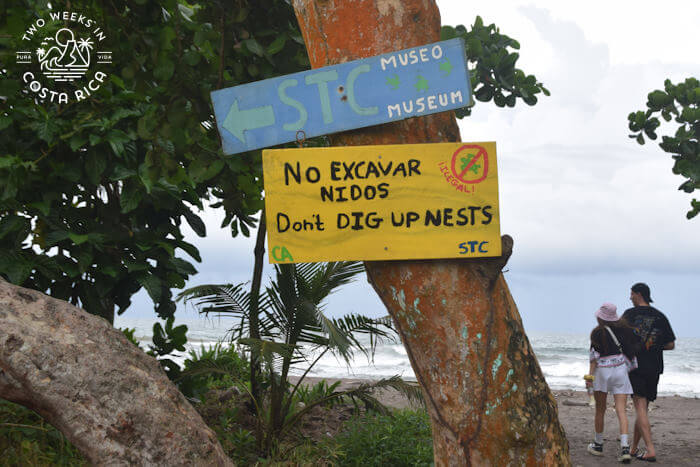
Other dangers the turtles face are wild animals. Jaguars prowl the most remote beaches during nesting season. A turtle is an easy meal for these big cats. Large birds like tiger herons or hawks also often prey on the hatching babies before they can reach the sea.
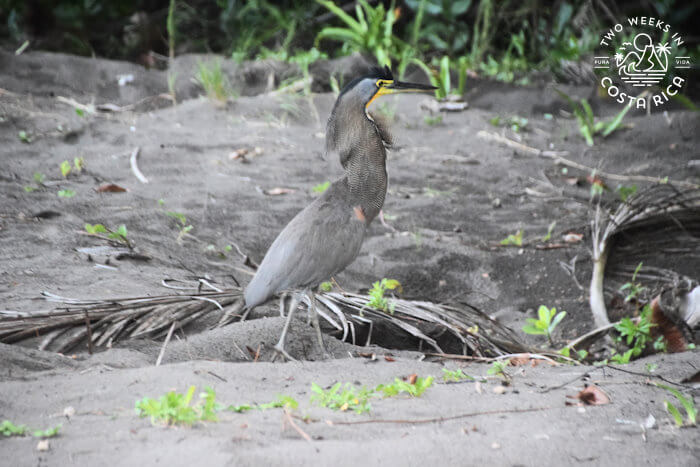
A slower but looming threat is climate change. A turtle’s sex is determined by nest temperature. Rising global temps are causing most hatchlings to be female. This will cause breeding problems for future generations.
Protection Through Tourism
A ray of hope for the turtles comes from something unexpected, tourism. Tortuguero’s economy depends on it. With tourists, come jobs in restaurants, hotels, transportation, tours, and more.
Local guides, who grew up with fathers, uncles, friends, or whom themselves were once poachers, can now make a living in other industries.
Just visiting Tortuguero gives the turtles more of a chance. And while it may seem counterintuitive, the more people who come to the area, the more it is protected.
Turtle Nesting Tour – Our Experience
Setting Out
Our tour started at the dock of our hotel where we loaded into a small boat and set off across the canal. It was already dark out, and the water was calm and glassy. We soon landed on the opposite bank and stepped onto the shore.
Here, our guide led us by flashlight across the Tortuguero airstrip, where small planes land during the day. Just on the other side, through some scraggly palm trees, was the beach. We could hear the powerful waves and feel a steady breeze.
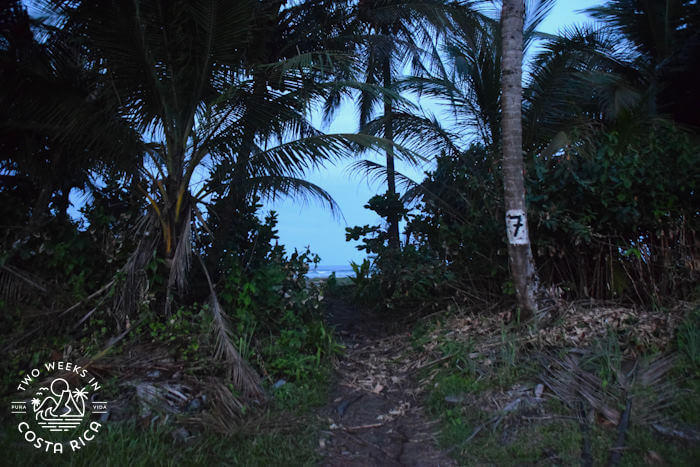
Our guide told us that we’d need to keep all flashlights off and not use our cell phones, cameras with flashes, or any other lights. Turtles that see lights often become disoriented and turn back to the sea, he said, and won’t lay their eggs.
Waiting and Wondering
Our group of six stood in the dark next to our guide. We didn’t really know what was happening. Other small groups stood near us, but it was completely black and we could barely make out the shadows of people, driftwood logs, and the ocean.
Soon our guide began to explain in a quiet voice. He told us that the Tortuguero National Park rangers are the ones who oversee and control the turtle viewing experience.
The rangers search the beach for nesting turtles then give each local guide a turn to witness the event with their group.
Continuing to wait, we learned that the six-mile-long beach is divided into five sectors. Each sector has 12 trails/access points. Up to 18 rangers patrol these areas. When they find a turtle beginning to nest, they communicate with the guides and share the location. But they spread everyone out to lower the impact.
Just the Right Moment
We soon found that patience was key for a turtle nesting tour in Tortuguero. The mother turtle must feel comfortable and remain undisturbed during the process. The rangers and guides are strict and serious about protecting them.
Our guide explained that the nesting mother must first dig a hole in the sand. The hole must be at least 30 cm (12 inches) deep. This depth is the same length as her back flipper, which she uses to measure. This is hard work and can take the mother some time.
Once the hole is complete, she will start to lay her eggs. Only at this point can tourists approach. It’s at this time, our guide said, that the mother goes into a sort of trance. She is in this trance, oblivious to her surroundings, until all 100 or so eggs are laid. This process takes 20-30 minutes, so during that time, groups can take turns watching her.
Our guide told us that we were just steps away from a turtle that was almost ready.
Counting Eggs
Just minutes later, we were given the go ahead—it was our turn.
Excitedly, we stepped softly through the sand to the nesting mother. Our guide’s red flashlight helped us find her. She was bigger than we expected at almost four feet (1.2 meters) long! The guide told us to position ourselves around the back of the turtle, so we’d have a view of the nest and eggs.
Under the red glow of our guide’s light, we watched large white eggs drop from the mother. Our guide instructed us to count the round eggs as they were released. Each one came slowly, with pauses in between. Our guide helped us count ten eggs (about five minutes), then we were told to move out of the way for the next group to see.
We got to see the process and count two more times before the mother was almost finished. Then the groups were led away so that she could cover her hole with sand and return to the ocean.
A Fond Farewell
As we walked away from the tired mother, our guide explained the rest of the process. The turtle would cover the eggs with sand using her flippers, then they would incubate for roughly 60 days. The hatchlings would then dig their way out and go directly to the sea.
He asked if we wanted to see the process again and wait for another mother to be ready. While the first time was exhilarating, we chose to call it a night and let the process take place without us. We felt confident that the turtle was not disturbed by us; we didn’t want to overstep our boundaries.
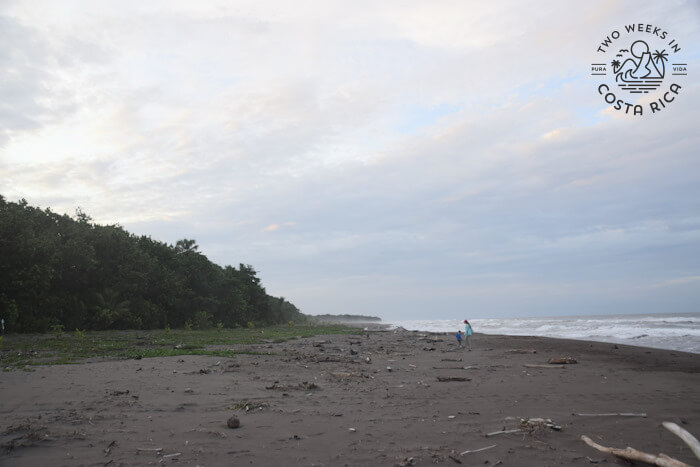
Hatchlings
As we boated back to the hotel, our guide encouraged us to return the next morning to look for baby turtles. Earlier nests were hatching daily, and the chances were good, he said.
After an early tour of the canals the next day, we walked the beach for several miles. It was amazing to see in the daylight how many holes had been dug by the turtles. There were indentations everywhere, even in odd places along the tree line!
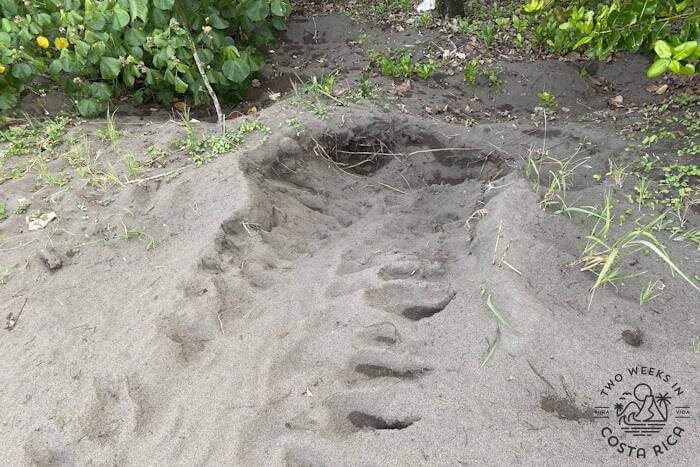
It was later in the morning than our had guide suggested, but we did find a few nests that had started to hatch. The turtles were still part way in their shells, but we could see their tiny flippers poking out from below the surface of the sand.
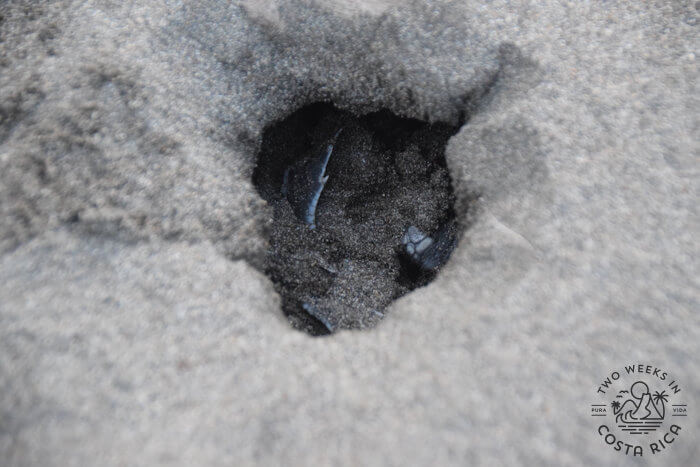
Conclusion
We were unsure what to expect on the turtle nesting tour in Tortuguero. We had seen olive ridley turtles nesting in Ostional and felt like we were intruding on a natural process there. But here in Tortuguero, we were really impressed at the efforts to not only protect the turtles from our influence but also how the magical event was shared as an educational and conservation lesson. After all, while the turtles may not know it, each tourist who visits them helps to ensure their safety and that of their hatchlings for generations to come.
Have a question about turtle nesting tours in Tortuguero or want to share your experience? Leave a comment below.
Looking for more information on Tortuguero? Check out these posts:
Cerro Tortuguero Hike and Viewpoint – This short hike in Tortuguero takes you through beautiful rainforest and up to an expansive viewpoint.
Getting to Tortuguero – Getting to Tortuguero is a little complicated but worth the effort.
Tortuguero National Park – In this article, we explain about the park’s land and waterway trails.
